Chapter 15- Politics, Government, and Issues
Child Labor
The United States has passed many laws at the city, state, and national levels that have impacted the U.S. family. From the country's earliest inception, settlers came with strong traditions and beliefs about what the family and its members "should" be like. Various laws were enacted, numerous traditions were set into place, and even though the system has common themes, there has never been complete consensus on what these laws and traditions "should" be for all of the population. Arguably, there can never be total consensus. But over time the majority has won the policy and legal battles -- a pattern that persists today. This chapter will discuss childhood, education, marital, and other issues in which the family interacts with the state, federal, and international governments and other institutions in society.
Children were not always protected and nurtured in the U.S. At times they were kicked out by their parents, being orphaned in a society that was hesitant to take in orphans. At other times they were beaten without any repercussion to the family or friends who mistreated them physically, sexually, and emotionally. In a truly unexpected historical process, it was the tenderhearted animal protection advocates who ended up facilitating the protection of children. An 1874 case where Mary Ellen Wilson was being beaten by her adoptive parents yet was rescued by the head of the New York Society for the Prevention of Cruelty to Animals proved to be a turning point in U.S. history as far as protection of children is concerned (retrieved 7 August 2020 from SOURCE).
Soon after this event, the first society for the protection of children was formed in 1875. After that, various labor and interest groups began promoting and advocating for better treatment of children. Eventually, in 1877 the American [Humane Society] Association formed as a coalition of animal and child protection groups. A psychologist named John Dewy (1859-1952) was also known as a national child protection and education advocate. He is attributed with making tremendous strides in behalf of children. He was also the 1899 President of the American Psychological Association SOURCE.

During the Industrial Revolution, workers of all ages were employed in the jobs that kept the economy going. Women and children were employed for lower wages than men, and children were quite often placed in harsh and sometimes dangerous jobs. Over the last century, formal efforts were made to protect children from exploitation in the workplace. The U.S. Department of Labor posts the children protection guidelines for those 18 and younger who are employed in the non-agricultural sector of the economy (see http://www.dol.gov/compliance/guide/childlbr.htm, retrieved 9 June 2014). As you read from these provisions, you will notice that the issue of schooling is factored in:
Minors age 16 and 17 may perform any job not declared hazardous by the Secretary of Labor, and are not subject to restrictions on hours. Minors age 14 and 15 may work outside school hours in various nonmanufacturing, non-mining, nonhazardous jobs listed by the Secretary in regulations published at 29 CFR Part 570 under the following conditions: no more than three hours on a school day, 18 hours in a school week, eight hours on a non-school day, or 40 hours in a non-school week. In addition, they may not begin work before 7 a.m. or work after 7 p.m., except from June 1 through Labor Day, when evening hours are extended until 9 p.m. The permissible work for 14 and 15 year olds is limited to those jobs in the retail, food service, and gasoline service establishments specifically listed in the Secretary's regulations. Those enrolled in an approved Work Experience and Career Exploration Program (WECEP) may work up to 23 hours in school weeks and three hours on school days (including during school hours). These are taken from Fair Labor Standards Act of 1938 (FLSA), as amended (PDF) (29 USC §201 et seq.; 29 CFR Parts 570 to 580).
By federal mandate, children are no longer exploited and put into danger. If that were to happen, the penalties to the business and corporation become punitive. Some form of schooling is also required. Today, many teenage children are employed part-time. Some work with their parents, others babysit or do odd jobs, and still others are employed in the community. Teens have been participating in the labor force by the millions. The child labor laws protect teens except the 19-year-olds, who are protected under the Occupational Safety and Health Administration.
In general the US labor force has changed and continues to change. The Bureau of Labor Statistics estimates of the proportion of labor force within a pyramid using age and sex for the population during the years 1950, 2000, and 2050. Figure 1 shows the lopsided nature of the US labor force in 1950. This reflects the relatively low numbers of women who participated in paid work outside of their homes back then. Notice how the blue bars for males and females ages 0-15 were wider than the bars above them. Women were still having lots of children and the Baby Boom (1946-1964) had not yet ended. Figure 2 shows that things were less gender lopsided by the year 2000 and that the workforce was rather large in comparison to the 0-15 and 65+ age groups.
But as Figure 3 shows, in 2050 , people have been living longer and birth rates have been decreasing. Those working in the labor force are proportionally smaller while those in the retirement years have increased. Figure 4 shows pie charts of US labor force and age composition for the years: 2000, 2010, and 2050. Notice the increase in the proportion of retirement-aged (55+) and the decreases of the proportions of working-aged groups 18-64.
Figure 1. US Population Pyramid with labor force for 1950*
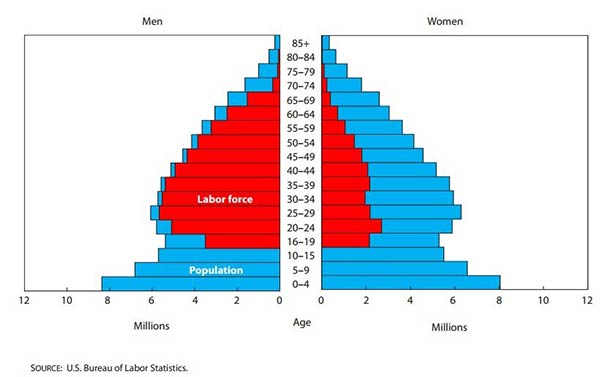
Figure 2. US Population Pyramid with labor force for 2000*
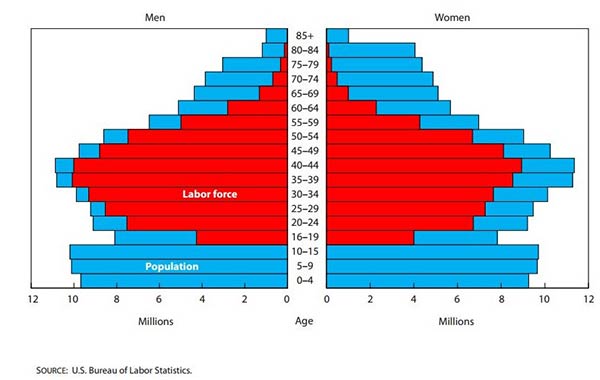
Figure 3. US Population Pyramid with labor force for 2050*
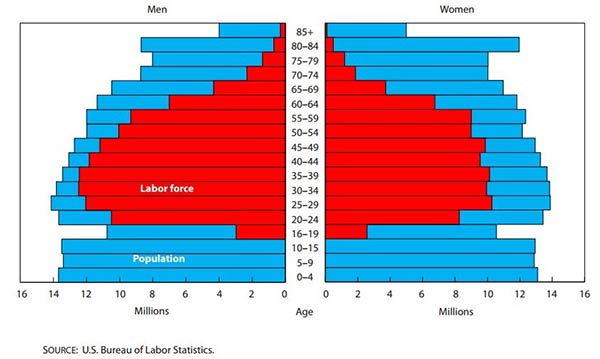
Figure 4. US Pie Charts showing Increases in Elderly and Decreases in Working Age with labor force for 2000, 2010, 2050*

Regardless of the motivation, early work experience benefits teens by helping them to get into college, building their resumes, and developing personal character and a strong work ethic. The St. Louis Federal Research Bank (2020) produced an interactive online time chart of the percent of teenagers ages 16-19 working in the Labor force. Figure 5 shows that the highest percentage of teens in the labor force transpired began in the 1960s and peaked in the late 1970s before declining to pre-1960s lows again around the year 2004. The short term and sudden drop in 2020 was due to the COVID 19 pandemic and it could return back to pre-pandemic levels in the next 6-12 months.
Figure 5. St. Louis Federal Research Bank (2020), U.S. Teens in Labor force (ages 16-19) for the years 1950-2020*

Education
Childhood education has been compulsory in the U.S. for more than a century, with the first mandatory education laws emerging in the northeastern states. In the U.S. today most children have to be educated between ages 5 and 18, depending upon state laws. The K-12, kindergarten through 12th grade, model is the most common model of education in the U.S. Students can attend parochial schools, private schools, public schools, and/or home schools. Public Schools are funded by the state (through taxation) and regulated by Boards of Education. Parochial Schools are typically controlled and funded through either private or religious organizations. Home Schooling is the process of educating children in the home using family, friends, and consultants as educators.
There has been a steady growth in the resistance among parents to send their children to public schools. Safety, religious concerns, quality of education, content of education, and other concerns relating specifically to the child have fueled this growth. Teachers unions and the National Education Association oppose home schooling in the U.S., yet homeschooling is increasingly being adopted in the U.S. and other Western nations as a common practice (Smith, Michael, http://www.hslda.org/docs/news/2013/201309030.asp, retrieved 9 June 2014).
Studies of home schooling versus other forms of schooling have shown trends in competence and, at times, excellence when comparing home-schooled to public-schooled student achievement (see http://www.hslda.org/docs/nche/000010/200410250.asp). Home-schooled children have recently won state and national spelling and geography bees, which has served as an affirmation to many homeschoolers about their efforts in behalf of their children. Many online home-schooling support websites have emerged to provide support and directions to parents who want to home-school their children (see www.K12.com, www.keystoneschoolonline.com, www.CalvertSchool.org, www.homeedmag.com, www.homeschoolcentral.com, or www.hslda.org). There is another 2017 article that shows the mixed findings on the need for teacher certifications and the comparative values of home schooling from many scientific studies (SOURCE).
Most U.S. children are educated in public schools. In 2013 there were 8.77 million nursery and kindergarteners, 32.7 million elementary, 17.0 million high school, and 19.9 million college students in the U.S. (retrieved 9 June 2014 SOURCE). Education plays a key role in the economic quality of life for children when they become adults. Here's the fact, pure and simple: More education means more money and opportunity in the United States. Typically, the higher your education the higher your economic status, power, prestige, and levels of property. Socio-Economic Status (SES) is a combination of one's education, occupation, and income and has been found to be highly correlated with a better quality of life for those in society who have higher SES scores. There is more job stability (less unemployment and more pay) for those with higher educations.
A 2013 recently published e-article articulated the many benefits of college graduation (see "Education Pays: The Benefits of Higher Education for Individuals and Society" by Sandy Baum and Jennifer Ma, in Trends in Higher Education Series 2013, retrieved 9 June 2014 Baum and Ma also pointed out that the higher your education the better your medical insurance, health, lifestyle for family and next generation, contribution to society, and more.
One other major U.S. education trend has been with charter schools. One major effort and reforming and transforming US public education has been the Charter School Movement. Since the early 1990s charter schools have become more and more popular existing in 45 of the 50 US states (See Rebarber and Zgainer (2014) Survey of America’s Charter Schools 2014 retrieved 11 June 2014 from SOURCE). In 2012 there were over 6,000 charter schools that served a higher proportion of: economically disadvantaged, non-White; and Hispanic students in comparison to public schools. The single most common theme of these charter schools remains college preparation (30% of all charter schools). More recent data suggests an ongoing increase in number and proportion of schools funded by states as charter schools. A 2020 NCES report stated that:
“Between school years 2000–01 and 2017–18, the percentage of all public schools in the United States (defined in this indicator as the 50 states and the District of Columbia) that were charter schools increased from 2 to 7 percent, and the total number of charter schools increased from approximately 2,000 to 7,200.” (see NCES The Condition of Education (May, 2020) “Public Charter School Enrollment” retrieved 16 July 2020 from SOURCE ).
Figure 6 shows the rates of charter school enrollment 2000 and 2017 by racial category. From 2000 to 2017 the proportion of Charter school students who were White and Black decreased slightly while the proportion of Hispanic increased. Charter schools account for 3.1 million enrolled students in 2017 and the state of California had the highest number enrolled of all states with a total of 627,000 students. To add further future growth to U.S. Charter Schools, the U.S. Supreme Court ruled in 2020 that it was constitutional for states to fund religious charter schools with public funds (See 30 June, 2020 ruling in Espinoza et al. v. Montana Dept. of Revenue et al. Retrieved 16 July 2020 from https://www.supremecourt.gov/opinions/19pdf/18-1195_g314.pdf ). This will likely lead to increased enrollments as many conservatives have been dissatisfied with public education content for decades leading up to this case and ruling.
Figure 6. Percentage distribution* of public charter school students, by race/ethnicity: Fall 2000 and fall 2017*
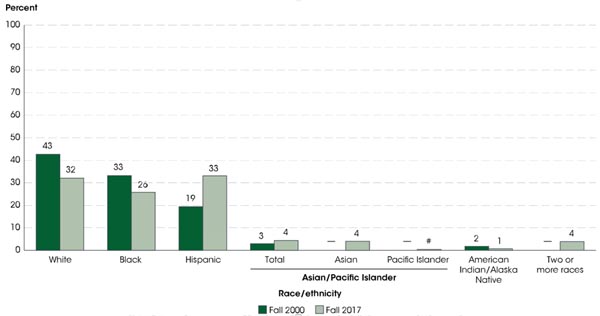
Education, especially earning degrees, is a doorway to many lifelong payoffs to college graduates. You need education because we live in a credentialed society. Credentialed Societies are societies that use diplomas or degrees to determine who is eligible for a job. The key in the U.S. is to graduate every chance you get. Certificate is 1 year past high school, Associate's is a 2-year degree, Bachelor's is 4-year degree, Master's is another 2-year degree past a Bachelor's degree, and Doctorate is another 4-6 years past a Bachelor's degree.
Look at Figure 7 below to see the relationship between higher education levels and the "American dream" or "Ideal" lifestyle. Education is the great equalizer and allows the tradition of college attendance and graduation to be introduced into any individual's personal and family life experience if they so desire and can muster the personal work and commitment along with the resources needed to attend then graduate. Tens of millions in the U.S. have zero, nada, or no medical or health care coverage. Most of them have lower education levels and little to no college education. The extremely poor and disabled may have limited government coverage, but most poor and near poor have no medical insurance.
Figure 7. How People Get the Best U.S. Jobs
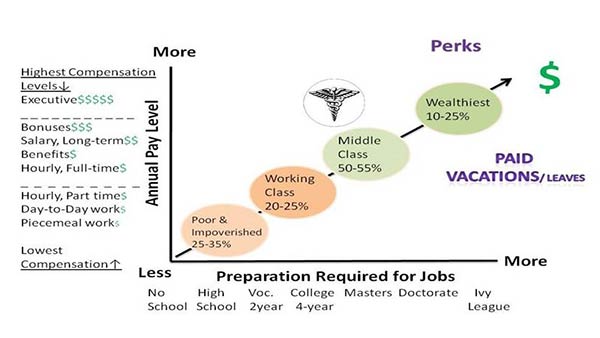
For the most part, working-class and middle-class people have some level of medical insurance. Interested in a job or career with yearly salary and not hourly pay? Interested in medical benefits and year-end bonuses with paid time off and vacations? Then you need at least a bachelor's, master's or doctoral degree, or you may be from the top 10-25 percent of our economic strata that are born into privilege. They get the educational levels, social networking, marriage market, and overall better life chances that only money can buy, including exclusive education, prep school, admittance into competitive programs, and Ivy League launch pads.
What Is The Relationship Between Education and Money?
Here’s the fact, pure and simple—more education means more money and opportunity in the United States. Typically, the higher your education the higher your economic status, power, prestige, and levels of property. Socio-Economic Status (SES) is a combination of one's education, occupation, and income and has been found to be highly correlated with a better quality of life for those in society who have higher SES scores. There is more job stability (less unemployment and more pay) for those with higher educations. In Figure 1 below you can see data extracted from the US Census Bureau on this.
Figure 8 shows the median weekly pay based on level of degree attained for the year 2019. These are not theoretical numbers they are actual pay levels for the year 2019 using sophisticated sampling procedures to ensure the data’s accuracy. You can see that the higher the degree you have earned the higher the median weekly salary. Those with Doctoral level degrees made about $1,880 per week which translates to approximately $97,760 per year. Those with a Masters degree made $1,497 per week or $77,844 per year. Those with a Bachelor’s degree made $1,248 per week or $64,896 per year. Then the median pay levels begin to decline. Those with an Associates degree made $887 per week or $46,124 per year while those who attended college but never graduates made $833 per week or $43,316 per year. Those with only a high school degree made $746 per week or $38,792 per year. Those with less than a high school diploma or GED made only $592 per week or $30,784 per year.
Why graduate with a bachelor’s degree? Well the pay is more than twice as high than high school graduates. The annual difference in median pay between a high school graduate and a bachelor’s degree graduate is an astounding $34,112 more ($64,896-$30,784) for bachelor’s degree graduates per year! If for no other reason, graduate with a bachelor’s degree. Maybe you feel a bit like I did. I was simply scared to death of failing and I was a First-Generation Student= which is a student who is the first member of their entire nuclear and extended family to attend college or university. I had no idea how to succeed in college and no one in my family who could walk me through it. In fact, when I first started college I was “academically dismissed” for 2 quarters of extremely low grades. That means I flunked out! I came back again after serving a volunteer religious mission. I was older and went to a college that was known for teaching students how to succeed and how to discover their academic strengths and areas that need improvement. One of the most important principles I learned was that colleges and universities are not constantly testing your academic skills everytime you take a quiz, write a paper, or submit and assignment. In fact, most are highly motivated to have as many students as possible complete their programs and graduate. That means they want you to succeed and will often do everything they can to help you figure it out so you do graduate. Another important principle I learned was that there is an entirely different culture of learning in college compared to high school and like any culture you may have to learn if you travel abroad, college and academics has to be learned.
Figure 8. BLS 2019 U.S. Median Weekly Pay by Level of Degree Attainment in 2019
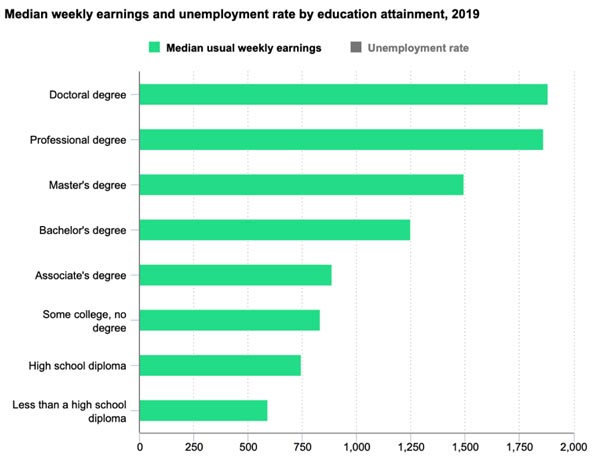
Another reason to graduate is that the unemployment rates are also much lower for more educated people in the U.S. Figure 9 shows the Unemployment levels by level of degree attained for the year 2018. These barcharts are very clear that the unemployment levels decline dramatically as the educational attainment (degrees earned) increase. Comparing only the bachelor’s to the high school graduates, the unemployment rate is much lower for those with a bachelor’s degree (2.2% unemployed) compared to high school graduates level (4.1% unemployed).
Figure 9 BLS 2018 U.S. Median Unemployment by Level of Degree Attainment in 2019
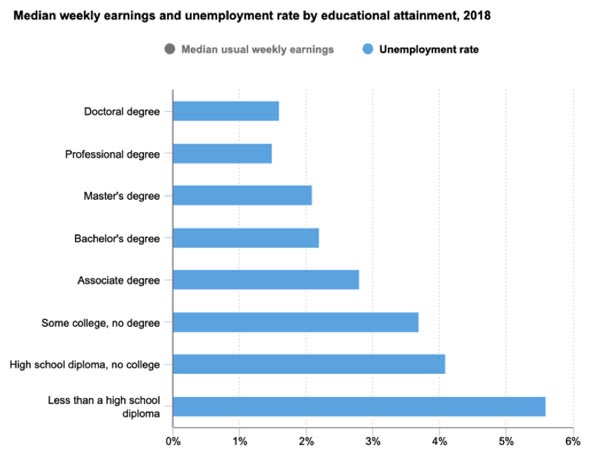
When students ask me how I feel about taking out student loans, I explain the following to them: If you choose to go to college and forfeit full-time wages to become a full-time student, you will lose about $126,000 of wages while in college. Plus, it might cost you another $25,000 in student loans or expenses. So you could conclude that it cost you about $151,000 to earn a 4-year degree. Subtract that $151,000 from the extra $697,000 and you end up with a $546,000 net increase in career earnings, even accounting for missed wages and student loan expenses.
So going to college pays. But how does dropping out of high school affect individuals and society?
Let’s revisit the dropout data we read in Chapter 2 then add a few dimensions of data to it. The worst possible scenario in terms of work and lifestyle is to drop out of high school. The National Center for Education Statistics regularly reports on academic performance. Figure 10 shows the Dropout rates for the US between 1975-2017. The High School Dropout rates ( not graduated or earned a GED nor enrolled in any institution by ages 16-24) has been higher for Whites aged 16-24 than for Blacks and Hispanics since 1975. But in all 3 racial categories, Dropout rates have been steadily declining over the last 45+ years. The declines are far more dramatic for Hispanics who had a much higher Dropout rate than Whites and Blacks.
Figure 10. US Ages 16-24: Status High School Dropout Rate between 1975-2017 (NCES)
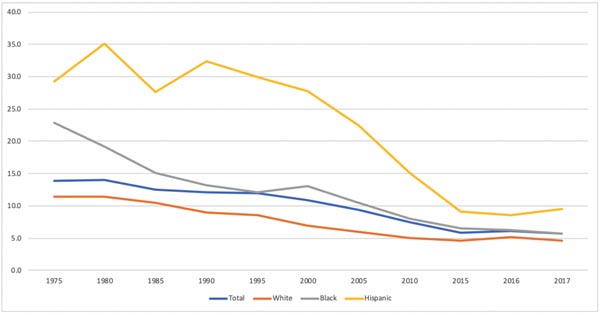
Again, the worst possible scenario in terms of work and lifestyle is to drop out of high school. And millions drop out each year in the US. Table 1 shows the dropout rates by racial classification for the US. Although all racial categories are showing improvement between 2011-2017, American Indians/Native Americans have the highest dropout rate in 2017 (10.1%); followed by Hispanics (8.2%); Blacks (6.5%0; Whites (4.3%); and Asians at only (2.1%). Dropping out of High School adds increased economic challenges through all that income lost; all that lifestyle forfeit; and all those other benefits of higher education missed.
Table 2 shows the dropout rates by racial classification for the US. In 2010-2011 for the total of all combined racial groups the overall dropout rate was 21 percent. By far, Asian/Pacific Islander Americans dropped out the least at only 13 percent, followed closely by Whites at 16 percent. Hispanics (29%), the economically disadvantaged (30%); Black/African American (33%); American Indian/Native American (35%); students with disabilities (41%); then students who have limited English speaking proficiency (43%) had the worst dropout rates—all that income lost; all that lifestyle forfeit; and all those other benefits of higher education missed.
Table 1: Dropout Rates by Racial Classification in the United States 2010-2017
| Group | 2017* | 2011° |
|---|---|---|
| AM. Indian (Native Am.) | 10.1% | 35% |
| Hispanic | 8.2% | 29% |
| Black (African Am.) | 6.5% | 33% |
| White (non-Hispanic) | 4.3% | 16% |
| Asian | 2.1% | 13% |
Marriage and Divorce Issues
On 26 June 2015, the U.S. Supreme Court ruled that same-sex couples have a right to marry anywhere in the United States. Typically, states register couples for legal marriage and now all states must allow heterosexual, lesbian and gay couples the right to marry. Generally speaking, in European and early U.S. history, marriage was a legal issue of property ownership -- the man had legal rights to his wife that fell clearly under the legal property right laws. Sad as it sounds, hundreds of years ago, a wife was a man's property. Historically a woman and man were married by the authority of a clan, tribe, religion, or family member.
Sexual orientation, desires, and behaviors have become extremely politicized. The largest sexual political action committee is the Human Rights Campaign which emerged in the 1980s as a "Gay Community" rights organization. LGBT and LGBTQ have replaced Gay Community as the collective acronym. LGBT stands for Lesbian, Gay, Bisexual, and Transgendered and occasionally Queer is added by some interests groups. The Human Rights Campaign has become the central political action organization for LGBTQ interest groups. On this Website, under "Issues" it lists: Aging, Coming Out, Hate Crimes, Health, Immigration, Marriage & Relationship Recognition, Military, Parenting, People of Color, Religion & Faith, Transgender, Workplace, and Youth & Campus Activism.
The "marriage and relationship recognition" became an emotionally charged political issue during the California Proposition 8 referendum and constitutional amendment that Passed November 2008. Because it passed the California Section 7.5 of the Declaration of Rights to the State Constitution now reads, "Only marriage between a man and a woman is valid or recognized in California." This set a strong national precedence against rights to same sex couples to have legally recognized marriage en par with heterosexual married couples. Estimates are that over $80 million was spent on this proposition alone on both the for and against efforts (see Wiki http://en.wikipedia.org/wiki/Prop_8 ).
The Prop 8 initiative originated from a political action committee called PAC . This PAC no longer exists but was self-describes as a "…broad-based coalition of California families, community leaders, religious leaders, pro-family organizations and individuals…to restore the definition of marriage as between a man and a woman."
The Defense of Marriage Act (DOMA) was signed into law by former US President Bill Clinton in 1996. It was the framework of regulating and structuring many aspects of our modern-day lives based on a federally defined structure of legal marriage as being between a "legal union between one man and one woman" and impacted over 1,000 laws and policies that were in-part based on the definition of marriage (SOURCE retrieved 13 June 2014, General Accounting Office GAO/OGC-97-16 Dated 31 January 1997). On 26 June 2015, the U.S. Supreme Court ruled in the case “Obergfell v. Hodges” that same-sex couples have a right to register for and be granted a state marriage license everywhere in the United States (see Wikipedia page SOURCE ).
A PewResearch 2017 study reported that that the US is more politically polarized than ever in its history with conservatives and liberals deeply entrenched in their own respective philosophical camps and with neither showing any indication of compromise. (see* PewResearch (20 Oct. 2017) “The shift in the American public’s political values” Political Polarization 1994-2017 retrieved 18 July 2020).
The report added that an increasing percentage of liberals and conservatives view the other major political party as "A Threat to the Nation’s Well-Being." This ruling essentially ended a 15 or so yearlong battle the U.S. experienced in what may prove to be the most historically divisive social issue in modern U.S. History. In Chapter 1, I briefly discussed how Andrew J. Cherlin identified the current state of marriage and what led up to it in very unique ways. Cherlin observed that of all the wealthier nations that have now legalized marriage between same-sex couples, the United States was the only country that had an extensive political and cultural battle about it. (see Cherlin, A. (2010). “The Marriage Go Round: The State of Marriage and the Family in America Today” Vintage Pub. 1st Ed ISBN 978-0307386380). There are many who see the Supreme Court ruling as being an attack on their way of life while others see it as a civil rights victory that grants all members of society the same treatment under the law.
Although the political battle over rights of states versus rights of individuals is not the only divisive issue in the US. As far as any family-related issues are concerned, it has already proven to be a harshly debated issue that separates rather than unites the general population; divides rather than unites various religious congregations; and divides rather than unites members of nuclear and extended families. In the meantime, heterosexual and homosexual couples continue to marry and cohabit, to raise children and grandchildren, to work and save for retirement, and fundamentally to pursue very similar goals. Few focus on the common ground each side already shares. Yet, as with all family related political controversies and battles, the family is very likely to come out of the political conflict in-tact, but is also very likely to emerge extremely different in terms of its structures and function. One hopes that the United States can persist in its resilience and hold fast to its individual and familial commitments to its respective family members and their well-being. Simply add, In an effort of unprecedented tolerance and unity between states and the LGBT community, on 11 March 2015, Utah passed a state law called the “Utah Compromise” which protected individuals religious freedom to act according to their own moral conscious in their public and private behaviors (a legal analysis and summary of the Utah Laws SB 297 and SB 296, 2014).” The Utah Compromise has drawn intense criticism from liberal and conservative organizations and critics. But, it offers hope for reconciliation and compromise.
Many nations that are economically similar to the US have their own patterns of family laws. For example, European governments asserted rights over legal marriages starting in about the 1700s. One law in Scotland was designed to stop secret marriages (see "An Act for the Better Preventing of Clandestine Marriage"). More and more governments demanded the right to declare a marriage as being legal. After the laws and traditions were in place, spouses were found to have certain rights and obligations toward one another. Children born to the same parents have consanguineous relationships with their parents and siblings, and these are often referred to as blood-ties or genetic ties in modern-day terms.
Upon marriage couples form matrimonial relationships with one another. These are called Affinal Relationships, which form through the marriage of a bride and groom and socially bind the extended family members into in-law type relationships. Also, long before genetics were discovered, Exogamy Rules applied, which mandated that adults marry outside of their family of origin and/or close range of cousins. For non-family members, Endogamy Rules apply, which suggest the need for a marriage of people of similar categorical backgrounds and walks of life. Table 3 shows a list of these rights.
Table 3. Modern-day Marital Rights and Obligations to Spouse in the United States
- To act as protector, nurturer, and supporter of one's spouse, even in difficult times
- To accept one's spouse's trials and calamities as your own while also accepting his or her gains or windfalls as your own
- To provide sexual pleasure and services to one another
- To declare (in almost all cases) exclusive sexual access and sexual fidelity to one's own spouse and none other
- To claim rights to property and legal protection under the state-recognized marriage
- To provide unpaid service to one another in support of the couple's overall economic well-being
- To co-own debts and obligations
- To own and claim rights to property, inheritances, and assets
- To serve as co-parents in the capacity of legal guardians of the children
- To have social and religious claim in extended family relationships
- To act, if needed, in each other's behalf legally and in informal ways
These rights and obligations may be obvious once you read them. But they provide clear boundaries that facilitate the smooth functioning of families in the larger context of society. Family laws and rights undergird the regulation and governance of private property, the upbringing of children, and the interaction of the state with individual families.
Death of a Spouse
What happens when a spouse dies? The man who loses his wife to death is called a Widower, while the woman who loses her husband to death is called a Widow. Property rights almost always default to the surviving spouse upon the death of a husband or wife. Prenuptial Agreements are contractual pre-arrangements agreed to prior to the marriage that identify the distribution of wealth if a divorce or death transpires. These agreements, if made according to law, trump traditional survivor and inheritance practices.
Wealthy couples who remarry, famous couples, and wealthier people who have more wealth at stake tend to make prenuptial agreements prior to marriage more than do average couples. One critic of prenuptial agreements told me that "a pre-nup is nothing more than an agreement to end the marriage before it ever really starts." I disagree. With great fortunes at stake, many children protect their inheritances from potentially greedy spouses by forcing or encouraging prenuptial agreements.
Inheritance patterns used to follow a patriarchal pattern of father to son. This was during the time of the early colonies that eventually formed the United States and also thereafter for decades. Remember, back then a wife was protected as the man's property. The widow was also felt to be protected by her oldest son. In modern law, the widow or widower now receives all assets and debt obligations of the deceased spouse. In a few societies, inheritances are passed from mothers to daughters to granddaughters, and these are called Matrilineal Inheritance Patterns. Patrilineal Inheritances are passed from grandfathers to fathers to sons.

Legal Wills are documents prepared by individuals and filed with the state in which the person lives and which dictates how inheritances and assets are to be distributed after the death of the individual. When there is no will (this is called Dying Intestate) and few assets, declaring the distribution of assets may not matter. Where a will is in place and is verified as being valid by the state (this is called probating the will), all creditors and debtors are notified and, after a lengthy court and legal process, the will is executed. This probation of the will can be very expensive. An executor (male) or executrix (female) legally ensures that the will is followed. A Living Trust is a legal action that puts a person's assets into an Internal Revenue Service-classification that shelters assets from taxes and protects the person's allocation of assets from the public eye. Again, wills and living trusts are more often utilized by wealthy and/or famous persons who have more property at stake.
Divorce Laws
What happens when marriages end in divorce? This is much more complicated than simple wills and trusts. Most couples have no prenuptial agreement, so assets and debts must be divided. Most couples have children, and if they are under age 18 when the divorce is filed for, then child custody terms have to be settled. During a divorce, Child Custody or Child Guardianship is the legal right an adult (most often a parent) has to act in behalf of a minor (less than 18 years old) child. During marriage, either parent can act in the child's behalf. After divorce, legal arrangements have to be articulated stating how the child or children will live since their parents are no longer married.
When divorcing spouses contest the divorce terms, costs can escalate into the thousands of dollars and court battles can persist for years. Child custody, alimony and palimony payments, division of property, false or real criminal allegations against divorcing spouses, and in extreme cases violence against parties involved highlight the recent literature and news media (see for example More Information than You Ever Wanted: Does Facebook Bring Out the Green-Eyed Monster of Jealousy?
Amy Muise, Emily Christofides, and Serge Desmarais. CyberPsychology & Behavior. August 2009, 12(4): 441-444. doi:10.1089/cpb.2008.0263 or "It is Just Good Business: The Case for Supporting Reform in Divorce Court" Rebecca Love Kourlisin Family Court Review Volume 50, Issue 4, pages 549–557, October 2012)
One of the most common settlements of child custody after divorce is joint custody. Joint Custody is an award of custody to both parents wherein the child is considered to live physically at both addresses (the mother's and the father's). The judge agrees to and signs divorce papers stating how the child support will be paid, how the children will visit the other parent over the course of the year, and how adjustments to the visitations arrangements are to be agreed upon and made. Child Support is a legal agreement on how much money a parent must pay for the care of a child after divorce. Child support is most often associated with sole-custody arrangements, but it may be present under joint custody as well.
Sole Custody is an award agreed to and signed by a judge in which one parent is considered the custodial parent and visitation with the non-custodial parent is scheduled over the course of the year. The phrase, "sole physical custody" is often used to describe sole custody, because the custodial parent spends the majority of the child's life with them and ensures that the non-present parent gets scheduled visitation with the child. A non-custodial parent is the visiting parent in this type of custody arrangement.
Often the non-custodial parent agrees to pay maintenance support to his or her ex-spouse in the form of alimony. Alimony is financial support to an ex-spouse (ex-husband or wife). Alimony may be short- or long-term rehabilitative to support an ex-spouse getting up on his or her feet as an independent breadwinner, and/or it may be compensatory, reimbursing an ex-spouse for support and investments made over the course of the marriage. The court considers the duration of the marriage, the spouses' ages, the income of both parties, the health of both parties, and if a party is female or male (alimony is more often awarded to females).
Child support payments most often are made directly to the state and dispersed according to court orders. When child support payments are not made, the non-custodial parent is considered delinquent and is often referred to as a "deadbeat parent." I personally dislike this label and find that an absence of payments of child support does not always a deadbeat make. There are disabled, challenged, and at times unemployed (or underemployed) parents who may desire to fulfill their financial obligations to the child but simply can't. When child support and/or alimony are not paid, ex-spouses often appeal to state recovery services agencies that have legal power to garnish wages and attach assets and tax returns so that divorce-decreed support is collected. As mentioned in chapter 12, no-fault divorce completely changed the nature of the divorce process and settlement in the United States.
For most of U.S. history, fault had to be proven in order for a divorce to be granted. I've often taught my students that prior to 1969 you had to prove that "your spouse was a louse to get them out of the house." Today, no-fault divorce is the common practice. In no-fault divorce, couples can dissolve a happy marriage, a functional marriage, even a convenient and congenial marriage with no regard to who is at fault for the marriage ending in divorce. California was the first to pass a no-fault divorce law, which went into effect in 1970 (see the California Family Law Act of 1969). All the other states except New York followed suit (most passed similar laws by 1983). Interestingly, other countries did not follow the no-fault example set by the United States.
No-fault divorce eliminated the need for the expenses of developing a court case and having an adversarial battle with the ex-spouse. It allowed couples to declare "irreconcilable differences" and simply move on with their lives, without each other. I personally know a 90-year-old man whose wife filed for divorce after a seven-year attempt at their first marriage (during the 1950s). He told me that the judge would not grant her a divorce, but he was willing to grant him one. It turned out that she refused to consummate their marriage (have sexual relations with him) but had sex with other men. In his words, "the judge said I deserved a divorce, but she didn't. So I agreed to end the marriage."
An Annulment is a legal decree that the marriage is void -- as though the marriage never happened. Annulments are decrees as though there never was a marriage. Annulments are not just handed out easily. They are often filed for very early in the marriage. They often take into consideration unexpected extremes such as failure to share the marriage bed, illegal activities and/or fraud, infidelity, and even insanity.
I personally know another man who discovered that his new wife had been unfaithful to him the day after they returned from their honeymoon. She had sex with her ex-husband. When the man made this discovery after their 15th anniversary, he confronted his wife. She filed for divorce and the marriage was ended in six months. Had the early affair been discovered immediately, he may have been able to apply for an annulment. In very rare cases, kidnapping can be grounds for an annulment. This might be if it was later discovered that one of the spouses was forced to marry in the first place (I realize how bizarre some of these extremes sound).
Divorce has been found in most societies and cultures of the world throughout most of the recorded history of humans. The society and state in which the divorce occurs greatly influences the reconciliation of assets and liabilities during the divorce process. For those with modest assets and liabilities, things can be worked out without going to court. For middle-class persons, collaborative or mediated divorces are more and more common. If there are children, mediation is required before divorces will be decreed. Many couples choose to work out their divorce terms with professional help but without attorneys -- this is where professional mediation helps.

Collaborative Divorces use attorneys for all the behind-the-scenes work and then file the results with the state courts. For Mediated Divorce, mediators who may or may not be attorneys work to find a mutually agreeable solution for both spouses. For those with more, things often end up litigated before a judge. Back in 2014 when making revisions for the 2nd edition of this book, Wikipedia reported that when Dmitry Yevgenyevich Rybolovlev divorced his wife it is estimated that they spent 4.5 billion U.S. dollars on the divorce (retrieved 13 June 2014 from SOURCE). As of 2020, Wikipedia has a list that moved Dmitry Yevenyevich from the number 1 spot down to the number 8 spot. Who had the most expensive divorce as of 8 August 2020? Wikipedia stated “Jeff Bezos's divorce in 2019 after 25 years from MacKenzie Bezos; is the most expensive divorce with MacKenzie Bezos getting $35 billion dollars ($35 billion inflation adjusted) (Retrieved 8 August 2020 from SOURCE
Community Property (also called marital property) is property acquired and obtained during the marriage, which neither person owned before the marriage. This includes all monies earned by either spouse during the marriage plus the assets they purchased with those monies. It may also include retirements and annuities earned during the marriage but not yet paid out. Separate Property was owned before the marriage, inherited during the marriage, or acquired after the separation. States vary on how the rules of consideration for division are considered in community property.
Most state laws mention "equitable division" when it comes to property division in divorces. But property rarely gets divided exactly equally. According to one website, "Only in Arizona, California, Idaho, Louisiana, New Mexico, Nevada, Texas, Washington and Wisconsin will division begin at 50-50 if the marriage ends in divorce" (retrieved 13 June 2014 from http://www.equalityinmarriage.org/wdget.html). Numerous sites offer free advice for those studying or considering divorce (see SOURCE). You might also be interested in the Cornell web page, which has an accurate summary of all 50 states' divorce codes
Cohabitation
Cohabitation is very common in the U.S., with tens of millions of cohabiters. Heterosexual and same-sex couples cohabit, and when their relationships end, they typically refer to common-law marriage laws if their state actually has these laws. Most states have done away with "common-law" laws. Common-law Marriages are cohabiting relationships that have no state license and typically have no marriage ceremony.
So, what is the difference between common-law marriages and simple cohabitation relationships? States vary, but where common-law is available these core issues are used in making distinctions: first, did the couple present themselves as spouses; second, are they of the same age required in the jurisdiction they live in to even be married; third, did they spend significant time together as a couple; fourth, did they share bank accounts; and fifth, are they legally marriageable (not still married to another)? The National Conference of State Legislatures reported that
Currently, only a few states recognize common-law marriages contracted within their borders. In addition, five states have "grandfathered" common law marriage (Georgia, Idaho, Ohio, Oklahoma and Pennsylvania) allowing those established before a certain date to be recognized. New Hampshire recognizes common law marriage only for purposes of probate, and Utah recognizes common law marriages only if they have been validated by a court or administrative order (retrieved 13 June 2014 SOURCE).
Adoption
Another important issue relating to legal issues of the family in the broader social context is adoption. Adoption is the formal process of making a child not born in a family become legally part of the family, having the same rights as a birth child is afforded. Adoptions are very common in the U.S. and the world. In every adoption, there is a birth mother, birth father, adopting parent or parents, and the government that will formalize the adoption process. In the U.S., one study suggested that 1.1 percent of women and 2.3 percent of men ages 18-44 have ever adopted a child. Another 1.6 percent of the population ages 18-44 want to adopt a child (retrieved on 11 June 2014 SOURCE ). In an extension of this data NCHS tabulated the statistics for 2006-2010. Their data shows that the percentage of females 18-44 years of age that have ever adopted a child is 0.9%. The percentage of males from 15-44 years of age that have ever adopted a child is 1.4% (retrieved on 11 June 2014 SOURCE ). A 2009 federal report commented on the characteristics of people who adopt who tend to be married, older, male, and have had various infertility issues (retrieved on 11 June 2014 from http://www.cdc.gov/nchs/data/databriefs/db12.pdf ).
Figure 8 shows the percentage of white, total, and black women who relinquished their child to adoption during the first month of life, starting pre-1973 and going up through 2002. In fact, this same report suggested only 1 percent did as of 2002, or fewer than 7,000 infants annually. In the subsequent years, the rate continues to hover around or below 1 percent because fewer and fewer women relinquish their newborns to adoption. Part of the reason is the availability of both abortion and contraception to the average unwed mother. The U.S. passed the 2000 Adoption Awareness Act, which trained pregnancy and health counselors on how to present adoption as an option to women with unintended pregnancies (SOURCE ).
Figure 11. Percentage of Children Born to Never-married Women Who Were Relinquished to Adoption During Their First Month of Life: Pre-1973-2002.
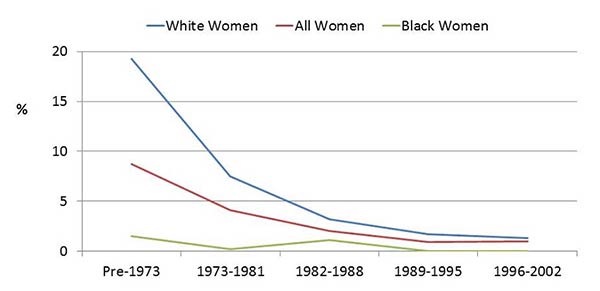
Adoptions are common both within and beyond the U.S. The Hague Convention on the Protection of Children and Co-operation in Respect of Inter-Country Adoption was passed in 1993. The U.S. signed on in 1994. As of 1 June 2014, 93 nations had signed on with this convention. Basically, participating nations ensure during adoption that the safeguards for children are in place for the best interest of the child, that the children are legally adoptable, that proper effort is given to the child's country of origin (laws and customs), and that all legal requirements are met by the country of origin and the country the child is being adopted into at the time of the adoption SOURCE.
When adoptions take place, great efforts are made to protect the confidentiality of children and parents, so statistics are often difficult to come by. In spite of this, a few statistics are known. According to the Child Welfare Information Gateway’s report titled Foster Care Statistics 2012, on September 30, 2012 there were an estimated 399,546 children in foster care. During the 2012 fiscal year, 254,162 new children entered foster care and only 241,254 children exited foster care. Of the estimated number of children in foster care in 2012, 53 percent had a goal of reunification with parents, 24 percent had a goal of adoption, and 5 percent had a goal of emancipation. The outcomes of these goals for the children that exited foster care were that 51 percent were reunited with families or primary caretakers, 21 percent were adopted, and 10 percent were emancipated. Of the estimated 399,546 children in foster care, 52 percent of these children were male and 48 percent were female. 42 percent were white, 26 percent Black or African American, 21 percent were Hispanic, 9 percent were other races or multi-racial and 3 percent were unknown or unable to determine (retrieved on 13 June 2014 SOURCE ).
The United States has an organization that assists families, states, and government entities with adoption issues. It is called the National Council on Adoption (www.adoptioncouncil.org). Even birth parents can go here for support. Biological fathers and mothers have to relinquish their rights to the child. This does not always take place if the father is out of the picture and does not know about the child, or if the father cannot be located. Many adoption advocates argue in behalf of consideration of fathers' rights.
In 1989 the United States provided crucial support for the United Nations convention on the Rights of the Child (SOURCE). The convention address the sovereign rights every child in every country in the world should have including: protection from being enslaved, abused, executed, being bought or sold. It declares that children do have certain rights including the right to live. As of the writing of this book nearly 195 countries had signed on which means they agree in principle and will work toward achieving these ideals. The United States is one of the few hold-out countries that has not signed on, seeing a tremendous amount of opposition from conservatives.
Parental Rights are the legal rights and obligations afforded to the birth or adopted parents. If a child is born, these legal rights are in place. If a parent adopts a child, then it is the court that grants him or her parental rights. These rights include obligations to care for and be responsible for the child. They also typically include custody of the child; visitation of the child; ability to represent the child and speak for the child in medical, legal, and social matters; responsibility to raise the child; obligation to keep the child safe and to ensure that the child is educated; and unfortunately obligation to be liable for any destructive acts the child may commit.
A parent or parents may voluntarily yield their parental rights to an adopting parent through the courts. In some cases the state has legal authority to take the rights of a parent under certain adverse circumstances. The parental rights have been supported up to the U.S. Supreme Court in numerous rulings. Grandparents' rights have been established thus far as being limited to the right to request visitation and not much else. Parental rights trump grandparent rights. But in extreme circumstances the best interest of the child is considered and courts may grant grandparents certain privileges if the court is trying to keep children off the welfare rolls (e.g., when the mother is in prison or jail).
Emancipation of a Minor is the legal process of a child being freed from control of his or her parents, which simultaneously frees the parents of obligations to the child. Emancipation of children is possible in most countries of the world, yet it is rare. A minor is a person younger than 18 in the U.S. and can theoretically apply for emancipation if so desired. The minor would petition the court with legal assistance for emancipation and, depending on the laws of that state, would have to prove a case and the capacity to support him or herself (of course with an attorney's help, which may even be paid for by the state).
Open Adoption is when information about the parents is shared between birth parents and adopting parents. Closed Adoption is when no information is shared between parents and confidentiality is enforced. Adoption is a different process than most other endeavors family members undertake. Adoption requires a fortitude that is not needed even when homes are purchased, marriages are entered into, and wills are probated. Adoption has a "cloud of uncertainty" that hangs over it. When parents want to adopt, they have to pay money for legal support, initiate a relationship with the birth parent (if the adoption is open), decide if they actually want to adopt the child, and then endure through the uncertainty of the adoption process that may take years.
Don't get discouraged about adoption. Thousands of parents adopt each year. Just realize that adoption includes the adopting parents, birth parents, grandparents (at times), courts, and multiple jurisdictions. My friends have one son they are the birth parents to and three adopted children. They went to Lithuania to adopt their second child. He had been abused and neglected, so it took them four years to even be able to hug him. They adopted their third child from California. They adopted their fourth child from Alabama. The children are all teens now, and the oldest child married last year. Sounds cut and dry, doesn't it?
Here is the rest of the story. Over the years they tried to adopt three children from a mother who was institutionalized for mental illness. They had those children for six months before the mother backed out. "Total emotional devastation" was how they described being torn from these children. Years later they called us and announced that they had two newborn twins that were extremely high-risk in health. They paid the mother and followed through with the legal process, but the mother backed out three days before her grace-period ended. She kept their money and placed the twins into the state foster system until she was released from prison.
My other friend who adopted took a year to get all the financial, legal, social, and physical issues resolved. Her adoption was finalized and she has been the mother of this wonderful young man for 10 years now. She told me that adoption is not the same as birth because there is always a small question mark floating above the whole thing. "That question mark is really big during the adoption process. Once it's all legal, my son's birth mother could show up at any time in his life. She could sue, she could kidnap him, or she could decide she needs to be his friend. I know these are not very likely, but we adoptive parents live with this when birth parents never have to."
Paternity is the establishment of one man as the biological father of a child. How can you know who the father of a child might be? I had a student in 1991 that narrowed down the potential father of her child to three college students that she had sex within in the course of a week. Thousands of years ago, it would have been nearly impossible to establish which provided the sperm that fertilized the egg. Today we have DNA tests. If the man and woman are married, then paternity is assumed to be assigned to the husband. If there is an out-of-marriage pregnancy, paternity can be established to within 99.9 percent accuracy with a DNA test involving only a painless swab inside the mouth. If the father is not the sperm donor, then the likelihood may range from zero (not the father) to a few percentage points. If the tested person is a close relative of the father (brother, father, or uncle) that can also be established.
A biological explanation of the test was available on 11 June 2014 SOURCE . When paternity and maternity are in place, legal guardianship is granted. A Legal Guardian is the steward or person authorized to act in behalf of the child in all manners. Guardianship is clear in cases of birth and adoption. But what happens in cases of criminal behavior, abuse, neglect, and other nefarious circumstances where the child is at risk of harm? State legal practice allows courts to appoint a guardian in place of the legal parents when needed. When this happens, legal guardianship may be granted for a period of time for the child.
A Guardian ad litem is an adult appointed to represent the interest of the child during divorces, abuse, neglect, or other hardships in which the child's interests need to be protected independent of the parents. When a court appoints an ad litem for a child, it is called a Court Ordered Special Advocate (CASA). In 1977, a Seattle juvenile court judge named David W. Soukup was concerned about making drastic decisions with insufficient information. From that first program has grown a network of more than 951 CASA and guardian ad litem programs that are recruiting, training and supporting volunteers in 49 states and the District of Columbia. (retrieved 11 June 2014 SOURCE ). One of my students served as a CASA, advocating for children in a bitter, other-accusing, and generally nasty divorce. She truly felt a need to protect the minor child and was given authority and legal backing to do so. In the end, the child's parents divorced, but their efforts to use this little girl as a pawn in their cruel game of divorce chess was greatly limited.
Another major trend in child care over the last 30-40 years has been the development of kinship care. Kinship care means care giving provided by grandparents, other relatives, or even friends, without the direct support of the child’s parents. Many non-White US subculture groups have practiced kinship care over the last few centuries. But, it has only been recent that the majority White families have been practicing it.
A recent report, published by the Annie E. Casey Foundation stated that the trend of diverting children who otherwise have been placed in foster care into kinship care has saved billions of dollars in care giving cost to state and federal governments. But at what cost? Many kinship care givers refuse to seek professional help and professional resources because they might be ashamed and because they might be protecting the child’s parents. If the kinship caregiver does not seek help outside the family, then none of the vast community resources (grants, medical care, therapy, education, caseworker evaluation, etc.) can be obtained for the family.
Oversight is needed if we truly want to provide children with the best placement experience. (For more information, see The Kinship Diversion Debate: Policy and Practice Implications for Children, Families and Child Welfare Agencies by the Annie E. Casey Foundation SOURCE ). In spite of this concern, recent scientific studies have documented the relative quality of children raised in kinship care giving compared to foster children and others. (See recent studies: Hong, J., Algood, C.L., Chiu, Y., and Lee, S. A. (2011). An Ecological Understanding of Kinship Foster Care in the United States. Journal of Child & Family Studies, 20(6), 863-872 and Winokur M, Holtan A, & Valentine D. (2009). Kinship care for the safety, permanency, and well-being of children removed from the home for maltreatment. Cochrane Database of Systematic Reviews, 1, 1-122.)
Additional Reading
Search the keywords and names in your Internet browser
For more information on International adoption rates and to view an interactive data table showing recent trends in international adoption, visit the website SOURCE
For further information on adoption options, visit the website, www.childwelfare.gov/pubs/f_adoptoption.cfm/
National Center for Education Statistics. http://nces.ed.gov/pubsearch Retrieved 11 June 2014 SOURCE
Annie E. Casey Foundation SOURCE
United Nations convention on the Rights of the Child SOURCE
U.S. Department of Labor posts the children protection guidelines for those 18 and younger who are employed in the non-agricultural sector of the economy SOURCE
Same-sex divorce SOURCE
Pew Research at SOURCE